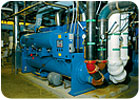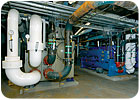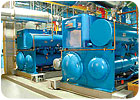
Figure
1. Essex County College personnel were at first hesitant to embrace gas
engine-driven technology, but they were eventually swayed by the life-cycle
costs. As a result, two water cooled 400-ton gas engine-driven chillers were
recently installed.
It’s no secret that energy costs have been spiraling upward over the last few years. In fact, the Energy Information Administration (EIA) states that energy prices have been on the rise since 2000. In its recently released Annual Energy Outlook 2007: With Projections to 2030, the EIA anticipates that prices will keep increasing over the upcoming decades due to rising production and transmission costs.
Even though the report notes that electricity distribution costs are projected to decline by 8% from 2005 to 2030 as technology improvements and a growing customer base lower the cost of the distribution infrastructure, transmission costs will increase by 29%. This is due to additional investment that will be needed to meet consumers’ growing demand for electricity and to facilitate competition in wholesale energy markets.
A way of offsetting these costs is for commercial, institutional, and industrial buildings to embrace dual-fuel technology, or hybrid plants. EIA notes that energy-consuming equipment in a building typically lasts from 10 to 30 years, which means that adjustments to buildings and equipment take many years, even if energy prices change dramatically. As stated in the report, “Because most previous disruptions in energy prices have been transitory, there is little evidence to indicate how quickly and how much the buildings sector could respond to a decades-long trend of increasing energy prices.”
The end result is that limited capability for fuel switching is the rule rather than the exception for equipment in buildings. Over a longer period, the report notes, existing equipment could be scrapped and replaced with new equipment that uses different fuels or uses the same fuel more efficiently. “The investments required to implement such changes would, however, compete with other uses of the funds available. Given the inherent uncertainty of energy prices, firms may be less than eager to invest in such measures as alternate fuel capability.”

Figure
2. The existing chillers had to be disassembled, hauled to the far end of the
mechanical room, and then taken out through the overhead door, while the new
chillers had to be assembled in place. Facilities personnel note that the new
chillers are surprisingly quiet.
College Embraces Change
Fortunately, institutions around the country are willing to make the investment in hybrid arrangements, given the uncertainty of future energy prices. One such place is Essex County College (ECC) in Newark, NJ. ECC was established in 1966 as the public, two-year, community college of Essex County and admitted its first students in temporary quarters in downtown Newark in 1968. ECC moved to its current permanent site in the heart of the University Heights district of the city in 1976.More than 25,000 people enroll each year in ECC’s various degree and non-credit programs, including students from over 40 foreign countries. The curriculum features close to 70 majors and 564 courses as part of a wide range of transfer and career programs.
The 22-acre main campus in Newark features a multilevel megastructure covering three city blocks, a two-level multipurpose Physical Education Building/Child Development Center complex, the Center for Technology, and the Clara E. Dasher Student Center. Among the resources of the 502,000-sq-ft megastructure are state-of-the-art laboratories, high-tech classrooms with advanced teaching modalities, the Mary B. Burch Theater for the Performing Arts, and a newly renovated library.
Until recently, the original three 760-ton, electric, centrifugal chillers kept the campus buildings cool, but their advanced age resulted in unreliable performance and inefficient operation. In addition, they all utilized R-11, which is both unfriendly to the environment and no longer being produced. A feasibility study performed by the engineering firm EI Associates (Cedar Knolls, NJ) indicated that two of the chillers needed to be replaced as soon as possible.
“We recommended that they replace the electric chillers with gas engine-driven chillers,” said Richard Basta, senior vice president of design with EI Associates. “They decided to replace one of the 760-ton electric chillers with one of like kind, and the second electric chiller was replaced with a pair of 400-ton gas chillers.”
The “like kind” chiller that was installed is a McQuay 760-ton, water cooled, centrifugal, electric chiller with heat recovery, while the two 400-ton gas engine-driven machines are water cooled Tecochill chillers. All three of the new machines utilize environmentally friendly R-134a, and all utilize the same new Baltimore Aircoil cooling tower. (The remaining existing chiller has its own cooling tower.)
Basta said that college personnel were at first hesitant to embrace the gas engine-driven technology, but they were eventually swayed by the life-cycle costs. It is estimated that gas engine-driven chillers can cut operating costs by as much as 30% to 60% compared with conventional electric chillers. This is mainly due to the fact that they can help a facility avoid electric demand charges and “time-of-day” rates.
Still, not everyone was convinced that the new technology was the best solution for ECC. The decision to install the gas engine-driven chillers had already been made when current physical plant engineer administrator, Gary Patel, came on board. “My first reaction was, ‘My God, who decided to install these chillers?’ I said, ‘Watch, when these machines are started, they’re going to make us lose our hearing, because they’re going to be noisy.’ These are 400-ton chillers, so the engines are huge.”
Patel was pleasantly surprised by the fact that the engines are well insulated, so noise is not much of an issue. “The Tecochill engines are completely insulated. They’re not quiet, but they’re not as noisy as I thought they would be.”
ECC had to replace the older chillers anyway, so Patel was happy to see the money being spent on equipment that would save energy costs. As he notes, demand rates during the summer “are a killer,” so relying on equipment that utilizes gas, which is cheaper than electricity during the summer, made perfect sense.
Out With The Old
Removing the two existing chillers was not an easy task. The mechanical room at ECC is large, but there is only a single overhead door at the far end of the room. The existing chillers had to be disassembled, hauled to the far end of the room, and then taken out through the overhead door, while the new chillers had to be assembled in place.As Basta notes, regardless of the type of chillers that were going to be installed, removal and installation would have had to occur in the same fashion. “Fortunately, the room was robust enough for the new machinery, so no major structural changes had to be made,” he said.
The only major difference between installing an electric chiller and a gas chiller was the fact that gas exhaust was required. Basta stated that in this application, it was necessary to go through four floors in order to install the gas exhaust line, which caused a few complications. “We required some additional floor openings for the exhaust, but fortunately, it was relatively minor,” he said. Hooking up the chillers to the existing Siemens BAS went smoothly as well.
When the new chillers were installed, the existing chilled water distribution system, including all the pumps, was re-used. The piping interface to the new chillers was a little challenging, because there were two chillers originally, and they were replaced with three machines. Basta said that made the design a little more complex, but they came up with the right solution for the space.
Patel would have liked to do a little more work on the existing system when the new chillers were installed. “The pumps should have been overhauled or at least cleaned, and the chilled water could be further improved. The college utilizes a dual-duct system. Interconnectivity between the chilled water and hot water system was originally designed to maintain precise supply water temperature to both the hot and cold deck, and that was great. However, when valves get old, chances of seepage through them increases. Modification and changes to the system is a continuous process.”
The whole college was built during a time when energy was inexpensive, but now changes must be made due to new environmental issues and rising energy costs. The director of the facility, Jeff Shapiro, as well as other leaders at the college, are supportive of improving the reliability and efficiency of the HVAC system. To help reduce energy costs, Patel reconfigured the system so that when the outdoor temperature is higher, hot air is brought from outside to supply the hot deck and heat the building. When the outside temperature is below 60°F or 65°, outside air is used to supply the cold deck. “Unfortunately, there’s only so much you can do, because there is one single fan driving both decks. If we had a separate fan, we could do it more accurately, but right now there’s only one fan and one louver to bring in the outside air,” said Patel.
More Changes To Come
Patel has more changes that he’d like to make at ECC, which is why he created a master plan. At the top of his priority list is to replace the last existing 760-ton chiller with a high-efficiency, cooling-only centrifugal chiller that uses R-134a and to use the heat recovered from the Tecochill engine coolant water for the hot deck. Patel also notes that his work is not yet done concerning the separation of cold and hot water in the piping system. This will involve a lot of “cutting and capping,” but he hopes to finish that work either this year or next. Then he can move on to other issues including air separators and filtration.As for the changes that have already been made, Patel is happy. He notes that the gas engine-driven chillers are working well, and the only issue he has with them is the additional maintenance they require. To make sure there are no surprises on maintenance costs, Patel chose to purchase a maintenance contract. “If anything goes wrong, Tecochill is required by contract to repair and replace it: parts and labor. That provides a kind of insurance.”ES

Sidebar: Chiller's heat recovery saves cold cash for NY rinks
The Great Neck Park District has gone all out to offer increased energy savings and a more enjoyable, comfortable indoor skating experience in its Parkwood Sports Complex in Great Neck, NY.During renovations of the Andrew Stergiopoulos Ice Rink, park officials added a new natural gas engine-driven chiller to provide a smooth, reliable skating surface for patrons. The new ice-making system also saves energy, making it economically possible to extend the annual skating season into spring and fall months. As an added benefit, it provides air conditioning so the building is able to serve as a summer recreation center.
Making all this possible is a new Tecochill CH-200x natural gas engine-driven chiller that provides 95 tons of cooling. The new chiller maintains a glycol-water mixture at 15ºF as it circulates beneath the ice sheet at the rink. It replaced an aging electric chilling system that was costly to operate.
In addition to using low-cost natural gas, thereby saving on the ice making costs and peak demand charges, the engine-driven chiller provides added efficiency and economy through heat recovered from the engine jacket coolant and the engine exhaust gases. The hot water generated is truly a byproduct, without any additional fuel consumption being needed. This waste heat from both the natural gas chiller and natural gas cogeneration module will be used throughout the sports complex. Eventually, some of this heat will also be used to warm an adjacent swimming pool.
Another important use for the chiller’s heat recovery is to provide the hot water for the Zamboni machine. Each time the Zamboni resurfaces the ice, it deposits 160 gal of hot water onto the ice surface. The hot water melts the top of the ice and freezes to form a fresh, smooth surface. By using the hot water byproduct from the chiller, the rink will be cutting its overall energy usage. In addition to saving energy, this hot water will also indirectly save wear and tear on the Zamboni tires and preserve the rink’s ice surface.
This totally efficient system is expected to save operating costs and bring in a steady stream of satisfied skaters.

